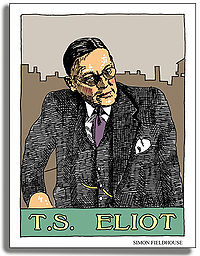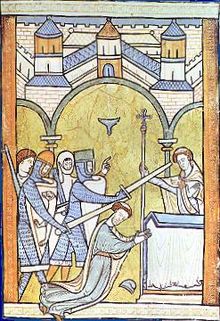- Murder in the Cathedral
-
Murder in the Cathedral is a verse drama by T. S. Eliot that portrays the assassination of Archbishop Thomas Becket in Canterbury Cathedral in 1170, first performed in 1935. Eliot drew heavily on the writing of Edward Grim, a clerk who was an eyewitness to the event.
The play, dealing with an individual's opposition to authority, was written at the time of rising Fascism in Central Europe, and can be taken as a protest to individuals in affected countries to oppose the Nazi regime's subversion of the ideals of the Christian Church.[1]
Some material that the producer asked Eliot to remove or replace during the writing was transformed into the poem "Burnt Norton".[2]
Contents
Plot
The action occurs between December 2 and December 29, 1170, chronicling the days leading up to the martyrdom of Thomas Becket following his absence of seven years in France. Becket's internal struggle is the main focus of the play.
The play is divided into two "parts" separated by an "interlude". Part one takes place in the Archbishop's hall on December 2, 1170. The play begins with a Chorus singing, foreshadowing the coming violence. The Chorus is a key part of the drama, with its voice changing and developing during the play, offering comments about the action and providing a link between the audience and the characters and action, as in Greek drama. Three priests are present, and they reflect on the absence of Becket and the rise of temporal power. A herald announces Becket’s arrival. Becket is immediately reflective about his coming martyrdom, which he embraces, and which is understood to be a sign of his own selfishness—his fatal weakness. The tempters arrive, three of whom parallel the Temptations of Christ.
The first tempter offers the prospect of physical safety.
- Take a friend's advice. Leave well alone,
- Or your goose may be cooked and eaten to the bone.
The second offers power, riches and fame in serving the King.
- To set down the great, protect the poor,
- Beneath the throne of God can man do more?
The third tempter suggests a coalition with the barons and a chance to resist the King.
- For us, Church favour would be an advantage,
- Blessing of Pope powerful protection
- In the fight for liberty. You, my Lord,
- In being with us, would fight a good stroke
Finally, a fourth tempter urges him to seek the glory of martyrdom.
- You hold the keys of heaven and hell.
- Power to bind and loose : bind, Thomas, bind,
- King and bishop under your heel.
- King, emperor, bishop, baron, king:
Becket responds to all of the tempters and specifically addresses the immoral suggestions of the fourth tempter at the end of the first act:
- Now is my way clear, now is the meaning plain:
- Temptation shall not come in this kind again.
- The last temptation is the greatest treason:
- To do the right deed for the wrong reason.
The Interlude of the play is a sermon given by Becket on Christmas morning 1170. It is about the strange contradiction that Christmas is a day both of mourning and rejoicing, which Christians also do for martyrs. He announces at the end of his sermon, "it is possible that in a short time you may have yet another martyr". We see in the sermon something of Becket's ultimate peace of mind, as he elects not to seek sainthood, but to accept his death as inevitable and part of a better whole.
Part II of the play takes place in the Archbishop's Hall and in the Cathedral, December 29, 1170. Four knights arrive with "Urgent business" from the king. These knights had heard the king speak of his frustration with Becket, and had interpreted this as an order to kill Becket. They accuse him of betrayal, and he claims to be loyal. He tells them to accuse him in public, and they make to attack him, but priests intervene. The priests insist that he leave and protect himself, but he refuses. The knights leave and Becket again says he is ready to die. The chorus sings that they knew this conflict was coming, that it had long been in the fabric of their lives, both temporal and spiritual. The chorus again reflects on the coming devastation. Thomas is taken to the Cathedral, where the knights break in and kill him. The chorus laments: “Clean the air! Clean the sky!", and "The land is foul, the water is foul, our beasts and ourselves defiled with blood." At the close of the play, the knights step up, address the audience, and defend their actions. The murder was all right and for the best: it was in the right spirit, sober, and justified so that the church's power would not undermine stability and state power.
Performances
 Movie poster for Murder in the Cathedral
Movie poster for Murder in the CathedralFirst performance
George Bell, the Bishop of Chichester, was instrumental in getting Eliot to work as writer with producer E. Martin Browne in producing the pageant play The Rock (1934.) Bell then asked Eliot to write another play for the Canterbury Festival in 1935. Eliot agreed to do so if Browne once again produced (he did). The first performance was given on June 15, 1935 in the Chapter House of Canterbury Cathedral. Robert Speaight played the part of Becket. The production then moved to the Mercury Theatre, Notting Hill Gate in London and ran there for several months.
Other notable performances
Robert Donat played Becket at the Old Vic in 1953 in a production directed by Robert Helpmann.[3]
Jonathan Frid played Becket off-Broadway in a production by Robert Teuscher for two weeks during March 1971 at Central Theatre, Park Ave., NYC, NY.[4]
The RSC staged revivals in 1972 at the Aldwych Theatre, with Richard Pasco as Becket,[5] and at The Swan in 1993[6] transferring to The Pit in 1994[7] with Michael Feast.
Television and Film
The play, starring Robert Speaight, was broadcast live on British television by the BBC in 1936 in its first few months of broadcasting TV.[8]
The play was later made into a black and white film. It was directed by the Austrian director George Hoellering with music by the Hungarian composer Laszlo Lajtha and won the Grand Prix at the Venice Film Festival in 1951. It was released in the UK in 1952.[9][10] In the film the fourth tempter is not seen. His voice was that of Eliot himself.
Opera
The play is the basis for the opera Assassinio nella cattedrale by the Italian composer Ildebrando Pizzetti, first performed at La Scala, Milan, in 1958.
Alternative versions of the same story
The play Becket, by the French dramatist Jean Anouilh, deals with the same historical events but places a different interpretation on Thomas Becket's conduct.[11][12]
Reception and criticism
Eliot's own criticism
In 1951, in the first Theodore Spencer Memorial Lecture at Harvard University, Eliot criticized his own plays in the second half of the lecture, explicitly the plays Murder in the Cathedral, The Family Reunion, and The Cocktail Party. The lecture was published as Poetry and Drama and later included in Eliot's 1957 collection On Poetry and Poets.
Parodies
In 1982, the play was lampooned by the Canadian/U.S. TV comedy show SCTV. In a typically surreal SCTV sketch, the play is presented by NASA and "Buzz Aldrin's Mercury III Players," with space-suited astronauts as the actors, and proceedings narrated by Walter Cronkite as if they were a NASA moon mission. "[Spacesuit transmission from astronaut] Mission control ... I think we've found a body." The mission is aborted when the doors of the cathedral will not open, and not even Becket's EVA can open them. [1]
Further reading
- Browne, E. Martin. The Making of T.S. Eliot's Plays. London: Cambridge University Press, 1969.
- Browne, E. Martin. "T.S. Eliot in the Theatre: The Director's Memories", T. S. Eliot - The Man and His Work, Tate, Allen (ed), Delta, New York, 1966
- Hoellering, George. "Filming Murder in the Cathedral." T.S. Eliot: A Symposium for His Seventieth Birthday. Ed. Neville Braybrooke. New York: Books for Libraries, 1968. pp. 81–84
- Robert Speaight. "With Becket in Murder in the Cathedral", T. S. Eliot - The Man and His Work, Tate, Allen (ed), Delta, New York, 1966
Notes
- ^ Stewart, Gaither. "Murder in the Cathedral or How the Sainthood of the Archbishop Became the Epiphany of the King", Southern Cross Review, 25 September 2008.
- ^ Eliot, T.S., New York Times Book Review, November 29, 1953
Cited and quoted in: T.S. Eliot: Four Quartets, A casebook edited by Bernard Bergonzi, Macmillan, London, 1969, page 23 - ^ "Papers of Robert Donat". Archives Hub. http://www.archiveshub.ac.uk/donat.html. Retrieved Oct 4, 2009.
- ^ Jonathan Frid. "A Summing Up: My Career On The Stage". http://www.jonathanfrid.com/misc.html.
- ^ "ROB WILTON THEATRICALIA: RSC 1970-74". Rob Wilton. http://www.phyllis.demon.co.uk/theatricalia/02rsc/rsc7074.htm. Retrieved Oct 4, 2009.
- ^ "ROB WILTON THEATRICALIA: RSC 1990-94". Rob Wilton. http://www.phyllis.demon.co.uk/theatricalia/02rsc/rsc9094.htm. Retrieved Oct 4, 2009.
- ^ "Theatre Previews and First Nights". London: The Independent. May 25, 1994. http://www.independent.co.uk/arts-entertainment/theatre--previews--first-nights-1438412.html. Retrieved Oct 4, 2009.
- ^ "The History of the BBC: Here's Television - Part 3". The Television History Resource Site. http://www.teletronic.co.uk/herestv3.htm. Retrieved May 8, 2009.
- ^ The New York Times Movie Reviews Murder in the Cathedral; Retrieved on October 7, 2006.
- ^ Murder in the Cathedral (1952) at the Internet Movie Database
- ^ IMDB: Becket (1964); Retrieved on October 7, 2006.
- ^ The New York Times Movie Review: Becket - 1964-UK-Biography [feature]/Historical Epic; Retrieved on October 7, 2006.
T. S. Eliot People - E. Martin Browne
- Valerie Eliot
- Vivienne Haigh-Wood Eliot
- Ezra Pound
- Jean Jules Verdenal
- William Butler Yeats

Early poems - Ariel Poems
- ("The Journey of the Magi")
- "Gerontion"
- "The Hollow Men"
- "The Love Song of J. Alfred Prufrock"
- "Portrait of a Lady"
- "Preludes"
- The Waste Land
Later poems - Ash Wednesday
- Four Quartets
- ("Burnt Norton"
- "East Coker"
- "The Dry Salvages"
- "Little Gidding")
- Old Possum's Book of Practical Cats
- ("Bustopher Jones"
- "Gus: The Theatre Cat"
- "Growltiger's Last Stand")
Plays - The Cocktail Party
- The Confidential Clerk
- The Elder Statesman
- The Family Reunion
- Murder in the Cathedral
- The Rock
- Sweeney Agonistes
Prose - "The Frontiers of Criticism"
- "Hamlet and His Problems"
- The Sacred Wood
- "Tradition and the Individual Talent"
Publishing Categories:- Modernist texts
- Fiction set in the Middle Ages
- Debut plays
- Plays by T. S. Eliot
- 1935 plays
Wikimedia Foundation. 2010.

